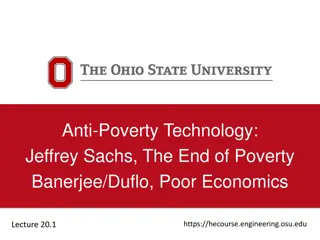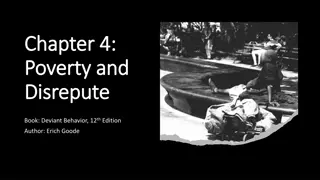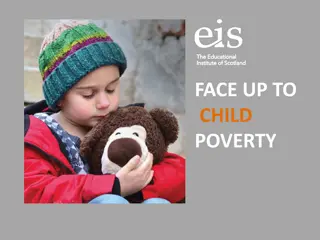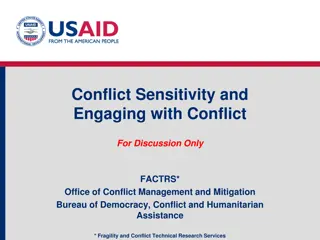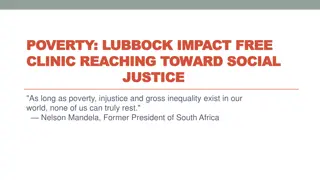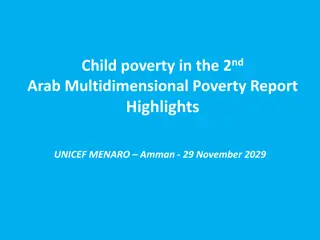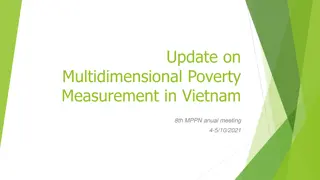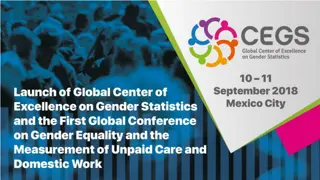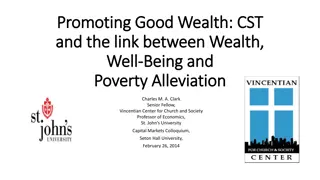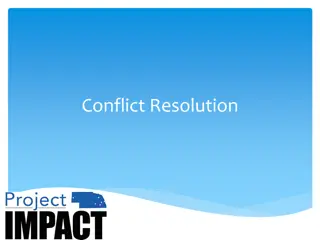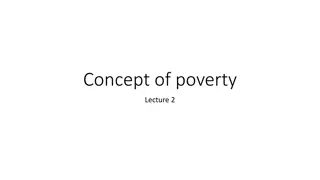The Impact of Conflict on Women's Poverty: Insights and Analysis
Poverty and conflict are intertwined in complex ways, where conflict reallocates resources away from development, exacerbating poverty levels. Chronic internal wars can lead to chronic poverty, particularly in states with collapsed governance systems. Addressing the multi-layered dynamics of conflict requires targeted interventions to influence short-term and long-term incentives, structures, and actors involved.
Download Presentation

Please find below an Image/Link to download the presentation.
The content on the website is provided AS IS for your information and personal use only. It may not be sold, licensed, or shared on other websites without obtaining consent from the author. Download presentation by click this link. If you encounter any issues during the download, it is possible that the publisher has removed the file from their server.
E N D
Presentation Transcript
The Impact of Conflict on Women s Poverty Eugenia Piza Lopez Senior Adviser, Team Leader Programme for Gender in Latin America and the Caribbean UNDP Bureau for Policy and Programme Support
Poverty and Conflict- not a linear relationship Focus to-date has been on poverty as the cause or consequence of conflict (extensive research) but on what enables this complex dynamic: More contemporary analysis look into the state and institutions- as they mediate interests that are intrinsic part of the dynamics of conflict. State and private institutions, formal and informal. The state as it engages, compromises its role as arbiter of different interests, redistributor of assets and guarantor of human rights. Conflict is not irrational breaking down of societies and economies it is the re-ordering of society in particular ways. In wars we see the creation of a new type of political economy, not simply a destruction of the old one" Violence may serve important functions and confer benefits on certain groups and individuals. Clauswitz characterised traditional nation-state war as the continuation of politics by other means. Frequently we are not talking about a conflict but an extremely complex multi layered conflict system in which a number of different conflicts interact with one another. In Afghanistan for instance micro level conflicts around land and water issues became entwined with the wider national and regional conflict. Research shows is that the impacts of war vary according to the nature, duration and phase of the conflict and the background economic and social conditions. However, chronic internal wars are likely to produce chronic poverty. This particularly applies to partialy or totally collapsed state, and it is particularly acute in war lord type conflicts like Sierra Leone, where the purpose of war was to make money and the combatants ensure that it lasts long enough to make serious money Poor societies are at risk of falling into no-exit cycles of conflict in which ineffective governance, societal warfare, humanitarian crises, and the lack of development perpetually chase one another. (Gurr et al, 2001:13). Moreover as many of today s wars are regionalised, the costs are often widely spread with neighbouring countries suffering from the spillover effects. Chronic poverty is a consequence of conflict and instability Conflict reallocates public resources away from productive activities and basic services, and leads to the loss of public entitlements, markets, and livelihoods, which increases poverty. There is unlikely to be any single policy fix and interventions should be multileveled, aim to influence short term and long term incentives and target structures, actors and conflict dynamics especially in cases of protracted conflict.
Development in Reverse: macro economic impacts of conflict Increased influence of military actors. Diverting resources to military (up on average from 2.8% of GDP to 5%) usually causes a decrease on other public expenditures like infrastructure and health An additional 2.2% of GDP now spent on military, sustained over the seven years that is the length of the typical civil conflict, would lead to a permanent loss of around 2 percent of GDP And .this doesn t include the losses associated with the rebel side s similar diversion of resources away from production into violence Diverting resources to military (up on average from 2.8% of GDP to 5%) usually causes a decrease on other public expenditures like infrastructure and health That additional 2.2% of GDP now spent on military, sustained over the seven years that is the length of the typical civil conflict, would lead to a permanent loss of around 2 percent of GDP And this doesn t include the losses associated with the rebel side s similar diversion of resources away from production into violence Growth During civil wars, economies grow around 2.2% more slowly than during peace After a typical seven-year civil war, incomes would be around 15% lower than if the war had not happened, and because of the effects of inflation and lost investment opportunities, the incidence of absolute poverty will have increased by 30% Using survey data from 18 countries affected by civil war, average annual growth rate was negative (-3.3%); also a wide range of indicators worsened during conflict: In 15 countries per capita income fell, In 13 countries food production dropped, In all 18 economies external debt increased as a % of GDP, In 12 countries export growth declined .
Development in Reverse: macro economic impacts of conflict Value of lost production instead of repairing roads and installing new irrigation systems to support expanded agricultural production, government recruits more soldiers and buys weapons and ammunition Costs of repairing destruction Roads that were damaged by tanks, and irrigation ponds that were destroyed by bombs, must be rebuilt or patched before they can work again Political capital Decline of the state and democratic political processes. Physical capital Destruction of, and lack of investment in infrastructure and services Insignificant post-war progress in policy in four key areas which might have been expected to improve after war ended, data shows either stagnation or continued deterioration Macro economies less stable, Structural policies on trade and investment less conducive to growth, Social policies less inclusive, Public sector less well managed
Development in reverse: social macro level impacts Civil wars kill far more civilians even after the conflict is over , than they kill combatants during the conflict. Much of this happens through infectious disease in refugee and IDP camps, but also through a break-down of primary health care services. Increased mortality is caused by both technical regress, or changes in living conditions that make staying healthy more difficult, and by government spending less money on public health because of continuing re-prioritization of public expenditures towards security. Social capital deliberately targeted or used to generate perverse outcomes. Natural capital - Break down of customary rights and rules of useage, predatory behaviour leading to resource depletion and environmental degradation, lack of management and investment in natural resources. Increased use of marginal lands Population displacements: forced migration, people fleeing to avoid violence or recruitment or looting of family assets Psychological damage: much harder to measure than mortality and morbidity from physical damage of war, but evidence shows psychiatric morbidity associated with mass violence in civilian and refugee populations is elevated when compared to non- traumatized communities Specific evidence of increased suicides amongst traumatized women of childbearing ages Landmines: affect both economic activity and physical health, acting in essence as a negative capital stock that the society accumulates during conflict but pays for afterwards Access to education and health care reduced Increased risk of predatory and contagious diseases in refugee habitations and camps
Social and economic impacts: micro- level Social Capital: Disruption of social relations, social dislocation, decline in trust and reciprocity. Household assets destroyed, looted wealth shifted out-of-country (capital flight, movement of herds across borders) Chronic conflict causes inter-generational exclusion-This is unlikely to suddenly change in the event of a peace settlement. Time horizons for economic transactions are shortened, efficiency suffers Family and community links are severed, social capital damaged loosens the constraints on opportunistic and criminal behavior, weakens the support networks for small businesses The effects of conflict are felt for many years after the fighting stops, and many of those who were chronically poor during the war are likely to remain so during the peace.
Integrated approach to understand the impact of conflict on women s poverty using a rights and a livelihoods framework: Integrated livelihoods Approach: Replaces income based definitions of poverty with a much more broad, inclusive and context specific examination of livelihoods. Household as the staring point and proposes the division of household assets into gendered forms of human, social, natural, financial and physical capital provides a useful framework for analysing how conflict impacts upon people, men and women in a differentiated manner. Exclusion and rights: Political marginality and the systematic denial of human rights - Exclusion as the denial of rights or incomplete citizenship. Takes into consideration structural violence, structural inequity and the unequal distribution of power (11 UNDP s political freedom index - which incorporates personal security, rule of law, freedom of expression, political participation and equality of opportunity -- provides a proxy indicator for the political dimension of exclusion and usefully highlights the link between politics and poverty and how they interface with conflict. Risks and vulnerability: household vulnerability is defined as the capacity of households to cope, manage and overcome shocks
Differentiation within differentiated approaches Chronic insecurity increases chronic poverty, but the impacts vary according to a range of factors including age, ethnicity, religion, sexual orientation and region. Classic conceptualizations of vulnerability may not apply; conflict may reverse pre-existing power relations causing new groups to become politically vulnerable. However, gender differentiations will be present in all cases and the key to understand the impact of conflict and conflict dynamics on women s poverty is to understand that Men and women experience war differently. Conflict has mixed impacts on gender roles and relationships. Armed conflicts result in tremendous changes to the lives and livelihoods of women: women take up new jobs, join armies, act as peacemakers and provide essential support to their families and communities Women also take on new roles. In Sri Lanka for Female-headed households are likely to be chronically poor, although not automatically so. For instance they have become active combatants (including suicide bombers) and in the North East, because of economic pressures they have increasingly entered the public realm. assume new roles and responsibilities In some contexts conflict may be temporarily empowering as women For instance the Tajik-dominated government established in Afghanistan in the early 1990s temporarily reversed the previous decades of Pashtun hegemony.. However these gains are often lost in a post conflict setting. An increased proportion of households become female-headed. Women experience acts of violence, including rape, which has been used as a weapon of war. Sexual violence has severe health consequences and rape has poverty implications for women who may be ostracized by their society. Radicalized, extreme religious based political violence has a direct impact on women s safety and poverty: lack of mobility, impediment of education as a right, refocused to private sphere, increased of family/domestic violence and sexual abuse, barbaric public displays of violence and an overall denal of women s right to employment and work including in subsistence agriculture. However, post-conflict policy processes tend to limit the capacity of women to participate fully and take advantage of new opportunities after the end of the war. Post-conflict contexts are currently characterised by a mismatch between policy priorities and women s needs and aspirations, and policy is being designed and implemented based on limited rigorous evidence on what works and what does not work for women and their families living in contexts of violence and poverty.
Policies fall short. In Bosnia, Colombia, Kosovo, Nepal, Tajikistan and Timor Leste research shows that women participate more actively in labour markets during conflict. these are usually low-paid, low-skilled jobs taken by women in addition to their usual household tasks, and reinforced by the type of gender livelihood programming implemented in post-conflict settings. Increases in the labour participation of women in conflict-affected areas are in some cases associated with increases in overall household and community welfare, when compared with households and communities in areas less affected by violence. This is a remarkable result is a testament to the resilience of women and their families under extreme conditions. However, recovery initiatives do not understand women s economic behaviors and options and stereotype support. At macro level Post war contexts have proved to be lacking in effective social and macro economic policy that focuses on the most vulnerable. There is a notorious fragmentation between economic policy, rebuilding institutional capacity and creating a new polity (liberal notions of economic and institutional reconstruction with similar size and shape fit all and the need to create new social pacts) Gender consideration are absent or nearly absent in post conflict reconstruction and not ever present in economic policy At the micro level Interventions result in flooding of markets with female-suitable jobs which tend to be short term and seldom result in direct empowerment gains for women and often contribute to increasing their levels of vulnerability. Women tend to lose their jobs once the war is over and face pressures to return to traditional roles. Women s voices are not heard beyond community-level responses.
So what is needed. More and new research on women, conflict and poverty Multiple dimensions of women s poverty required inter-sectoral and comprehensive approaches to work towards women s economic, political and physical autonomy Identify/understand the key dimensions of women s poverty in conflict/post conflict and integrate into macro economic recovery policy Address issues of violence and political voice as a key pre-condition for effective economic engagement Engage women in policy dialogue and consult proactively and systematically Develop local economic strategies based on women s centered value chain economies and insert women more effectively into those economies that are being pushed to increase productivity

 undefined
undefined




